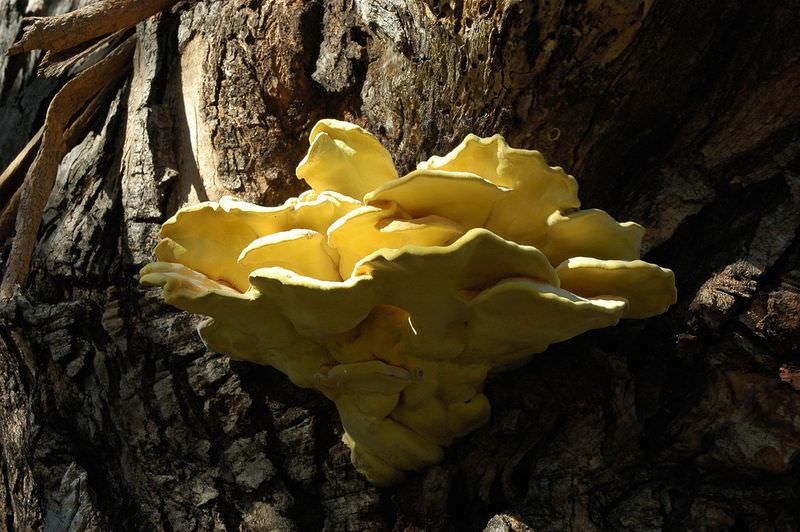8.8 菌菌
章节大纲
-
What exactly is a fungus?
::什么是真菌?They're not or plants, and definitely not . So they cannot photosynthesize or eat. And they are much more than mushrooms .
::它们不是植物,也不是植物,绝对不是。所以它们不能光合作用或吃。它们比蘑菇还多。Characteristics of Fungi
::蘑菇的特征Do you see the organisms growing on the bread in the Figure ? They belong to the Fungi . Molds growing on foods are some of the most common fungi in our everyday lives. These organisms may seem useless, gross, and costly. But fungi play very important roles in almost every on Earth.
::你看到图中面包上生长的生物了吗?它们属于真菌。在食物上生长的霉菌是我们日常生活中最常见的真菌。这些生物可能看起来毫无用处、粗糙和昂贵。但真菌几乎在地球上的每一个地方都发挥着非常重要的作用。The mold growing on this bread is a common fungus.
::面包上的霉菌是一种常见的真菌Fungi (singular, fungus) are a kingdom in the Eukarya . The fungi kingdom may contain more than a million , but fewer than 100,000 have been identified. As shown in the Figure , fungi include mushrooms and yeasts in addition to molds.
::如图所示,真菌除了霉菌外,还包括蘑菇和酵母。Several examples of fungi are pictured here.
::本文描绘了几例真菌的例子。Most fungi are multicellular, but some exist as single . Single-celled fungi are known as yeasts. Fungi spend most of their in the haploid state. They form diploid cells only during . Like the cells of protists and plants, the cells of fungi have cell walls . But fungi are unique in having cell walls made of chitin instead of cellulose . Chitin is a tough that also makes up the exoskeleton (outer skeleton) of and related organisms.
::大部分真菌是多细胞型的, 但有些是单细胞型的。 单细胞型真菌被称为酵母。 真菌大部分花在杂交状态中。 蘑菇只形成低细胞。 象原生细胞和植物细胞一样, 真菌细胞有细胞壁。 但真菌是独一无二的, 其细胞壁是由而不是纤维素制成的。 Chitin 是一种难耐, 也构成外骨骼( 外骨骼) 和相关生物。Habitats of Fungi
::菌菌栖息地Fungi are found all around the world, and grow in a wide range of habitats , including deserts. Most grow in terrestrial environments, but several species live only in habitats. Most fungi live in soil or dead matter, and in symbiotic relationships with plants, animals, or other fungi. Fungi, along with that are found in soil, are the primary decomposers of organic matter in terrestrial ecosystems. The decomposition of dead organisms returns nutrient to the soil, and the environment.
::菌类遍布世界各地,生长在包括沙漠在内的多种生境中,大多数生长在陆地环境中,但有几种物种只生活在生境中。大多数真菌生活在土壤或死物中,与植物、动物或其他真菌有共生关系。真菌以及土壤中发现的真菌是陆地生态系统有机物质的主要分解物。死亡生物的分解使土壤和环境产生营养。Science Friday : Fungal Freeways
::星期五:星城高速公路Fungus use fluid networks, similar to roads and freeways, to move nutrients and through their cells. In the video by Science Friday , Dr. Marcus Roper explains how these networks function with remarkable efficiency and prevent microscopic traffic jams.
::马库斯·罗珀博士在科学周五的录像中解释了这些网络如何以惊人的效率运作,防止微小交通堵塞。Summary
::摘要-
Fungi are a kingdom in the domain Eukarya that includes molds, mushrooms, and yeasts.
::蘑菇是欧卡里亚的王国 包括霉菌、蘑菇和酵母 -
Most fungi are multicellular. They are unique in having cell walls made of chitin.
::大部分真菌是多细胞型的, 其独特之处在于细胞墙是由奇廷制成的。 -
Most fungi live on dead matter or soil. Some live in aquatic habitats. Many are involved in symbiotic relationships.
::大部分真菌生活在死物质或土壤上,有些生活在水生生境中,许多与共生关系有关。
Review
::回顾-
What are fungi? Give two examples of fungi.
::什么真菌 举两个真菌的例子 -
Explain the significance of the chitin cell wall of fungi.
::解释真菌的细胞墙的意义 -
List two habitats where fungi live.
::列出有真菌栖息地的2个栖息地。
-
Fungi are a kingdom in the domain Eukarya that includes molds, mushrooms, and yeasts.


